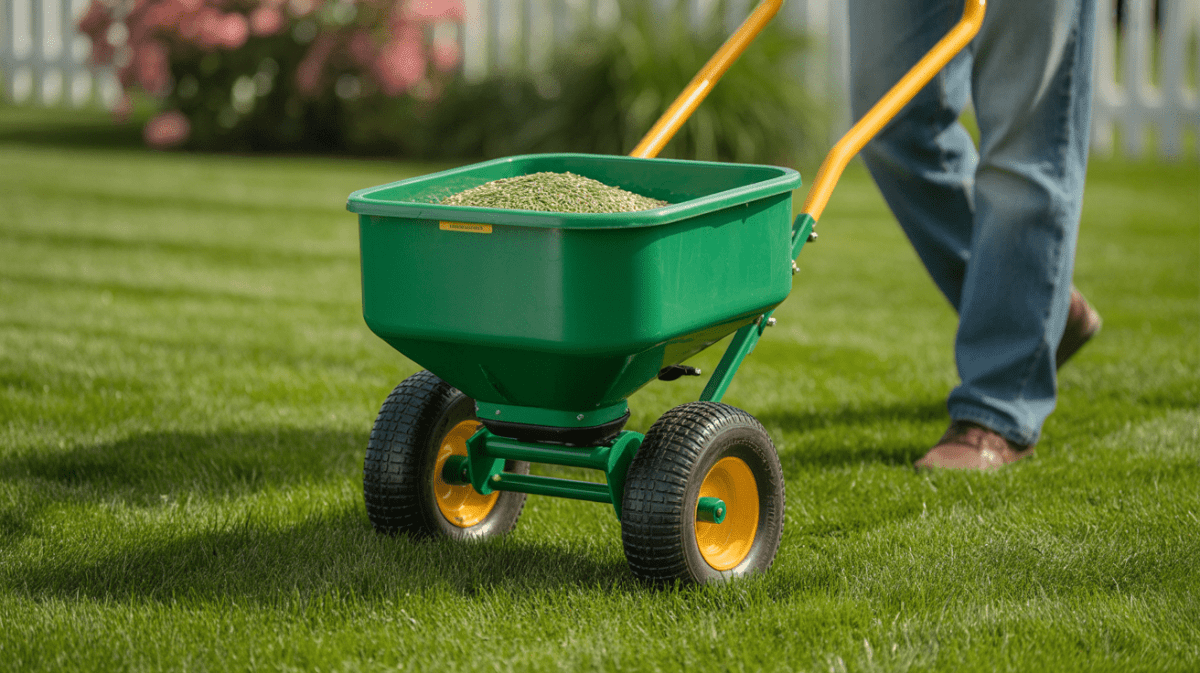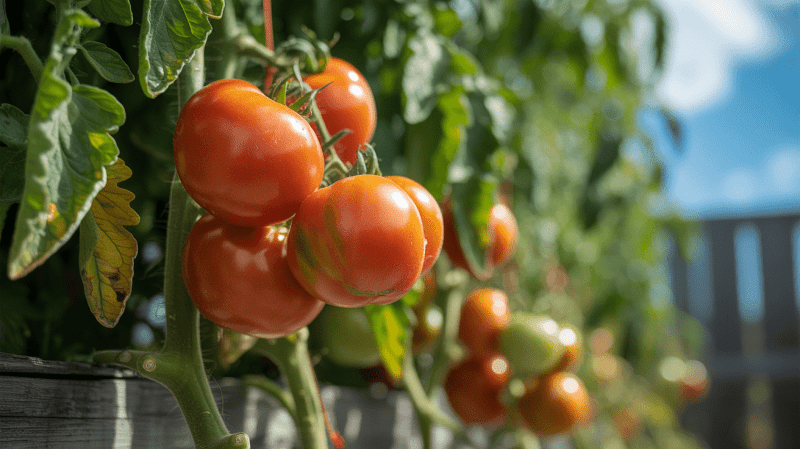The Best Grass Seed to Plant in Fall for a Thicker Lawn

Do you dream of a lush, green lawn that impresses everyone? Autumn is the ideal time to make your lawn look its best. The cool mornings and warm afternoons are ideal for growth.
Young seedlings grow better in cooler air. And warm soil helps them develop strong roots. This combo makes your lawn thicker and healthier.
When to plant is crucial in the fall. The best time is usually around Labor Day. This allows your grass to grow strong before winter.
Studies show lawns planted in the fall can grow up to 49% thicker by spring. This turns any yard into a stunning landscape.
Key Takeaways
- Autumn provides ideal conditions with warm soil and cool air
- Strong root development occurs best during the fall months
- Labor Day timing gives seedlings a perfect establishment window
- Proper fall planting can yield significantly thicker lawns
- Cool-season grasses respond exceptionally well to autumn seeding
- Reduced weed competition helps new grass thrive
- Establishment before winter ensures spring green-up success
Why Autumn is Ideal for Lawn Seeding Success
Fall is the best time to seed your lawn. The soil is warm, and the air is cool. This mix is perfect for new grass to grow strong roots before winter.
Soil stays warm from summer, but the air cools down. This allows grass to grow roots quickly without becoming stressed. Your new grass can grow deep and strong.
Weeds grow less in the fall. Annual weeds have finished growing, and perennial weeds slow down. This allows your new grass to receive more nutrients and sunlight.
Autumn's moisture helps your seeds grow. Morning dew and fall rains keep the soil wet. This is key for seeds to sprout.
Seeding in autumn means your lawn is ready for winter. It has strong roots that can handle cold and dry weather. When spring comes, your grass will grow fast.
Using an autumn grass seeding guide helps you make the most of the fall season. The right timing and techniques lead to a thick, lush lawn in the fall. Your lawn will remain healthy throughout the year.
This approach to planting fall grass seed makes your lawn stronger. It can better withstand drought and diseases. You're creating a tough and beautiful lawn.
Choosing the best grass seed for a thicker lawn in autumn is key. Your grass will grow denser and have deeper roots. Your lawn will look great and last longer.
The Best Grass Seed to Plant in Fall for a Thicker Lawn

Choosing the right grass seed is key to a great autumn lawn. The cooler weather is perfect for cool-season grass to grow strong roots.
These grasses do better in the fall than in the spring. They grow well in cool weather and get ready for winter.
Three grasses are top picks for lawn repair autumn projects. Fine fescue is easy to care for and loves dry weather. Kentucky bluegrass produces a thick, soft lawn that thrives in shade. Perennial ryegrass grows rapidly and can withstand heavy foot traffic.
Your local climate is crucial for selecting the right seeds. The U.S. is divided into growing zones A to M. Northern zones need cold-tolerant seeds, while southern zones prefer heat-resistant ones.
Here are some popular choices for different areas:
| Grass Type | Best For | Key Benefit |
|---|---|---|
| Fine Fescue | Shady areas | Low water needs |
| Kentucky Bluegrass | Northern lawns | Self-repairing |
| Perennial Ryegrass | High traffic areas | Fast germination |
Many wonder whether to seed or sod their lawn in the fall. Seeding is more cost-effective for large areas and offers a greater variety of options. It's great for specific lawn needs.
Quality seed blends, such as Scotts Turf Builder or Pennington Smart Seed, are good choices. They mix grasses for sun and shade, and are specifically designed for your region.
Your soil and sun exposure help pick the right blend. Sunny spots need drought-resistant grasses. Shaded areas require grasses that thrive in low-light conditions.
Choosing the right seed is the first step to a thicker lawn in the fall. The right seed helps your grass grow fast. It sets the stage for a healthier, denser lawn next spring.
Don't forget to check with your local extension office. They provide advice tailored to your growing zone. This ensures you pick the best grass for your area.
Your Step-by-Step Guide to Fall Overseeding

Ready to transform your lawn this autumn? Follow this straightforward guide to overseeding lawn fall success. These proven steps will help you achieve that lush, carpet-like lawn you've been dreaming about.
1. Prepare Your Lawn Foundation
Start by mowing your existing grass shorter than usual. Set your mower to about 1.5 inches high. This helps the new seeds reach the soil better.
Remove all clippings and debris with a sturdy rake. If your lawn has thick thatch, consider dethatching or aerating. These steps create the perfect bed for your new grass seeds.
For problem areas, add a thin layer of weed-free topsoil. This gives your seeds extra nutrients and better contact with the ground.
2. Select and Apply Quality Seed
Select a high-quality grass seed blend that matches the characteristics of your existing lawn. Look for varieties that thrive in your specific climate and soil conditions.
Use a broadcast spreader for even distribution. This prevents patchy growth and ensures consistent coverage across your entire lawn.
Apply a starter fertilizer right after seeding. This provides your new grass with the essential nutrients it needs for strong, early growth.
3. Ensure Optimal Seed Contact
Lightly rake the seeded areas after application. This gently works the seeds into the soil without burying them too deep.
Consider mulching with a thin layer of straw. This helps retain moisture and protects seeds from birds and harsh weather.
Proper seed-to-soil contact is crucial for germination. Don't skip this important step in your fall lawn care tips routine.
4. Implement Proper Watering Routine
Water your newly seeded lawn lightly but frequently. Keep the soil consistently moist like a damp sponge.
Water early in the morning to reduce evaporation. Avoid evening watering which can promote fungal diseases.
As grass begins to grow, gradually reduce watering frequency. This encourages deeper root development for thickening grass in autumn.
5. Follow Up with Fall Maintenance
Once grass reaches 3 inches high, you can mow carefully. Use a sharp blade and never remove more than one-third of the blade height.
Continue with regular fall fertilization. This supports both established grass and new seedlings through the winter months.
Keep leaves cleared from your growing lawn. A thick layer of leaves can smother new grass and block sunlight.
| Fall Overseeding Task | Best Timing | Key Tools Needed | Pro Tip |
|---|---|---|---|
| Soil Preparation | Early September | Rake, dethatcher | Test soil pH first |
| Seed Application | Mid-September | Broadcast spreader | Use half rate in two directions |
| Watering Schedule | Daily for 3 weeks | Oscillating sprinkler | Use timer for consistency |
| First Mowing | 3-4 weeks after seeding | Sharp mower blade | Bag clippings first time |
| Fall Fertilization | Late October | Drop spreader | Use winterizing formula |
Following these steps consistently will help you achieve a thicker lawn in the fall. Remember that patience pays off - your efforts now will reward you with a beautiful lawn next spring.
Conclusion
Fall is the best time to grow a healthy lawn. The cooler weather and steady moisture help grass seed grow well. Planting in September allows your grass to become strong before winter.
Choosing the right grass type is key. Cool-season grasses do well in autumn. Follow these good seeding tips for lush, healthy growth.
Even if you missed the early fall planting season, you can still plant in November. This method lets seeds grow during the winter thaw. They'll be ready to grow in spring.
Your hard work this autumn will pay off. A well-maintained lawn will look great all year round. Start now for a beautiful yard next season.
FAQ
Why is fall the best time to plant grass seed?
Fall has warm soil and cool air, making it perfect for developing strong roots. This means a thicker, healthier lawn by spring. With fewer weeds and morning dew, your grass can thrive.
When exactly should I plant grass seed in the fall?
Seed around Labor Day or shortly after. This gives your grass 6–8 weeks of great growing before frost. Field trials show lawns can be up to 49% thicker by spring.
What type of grass seed should I use for fall planting?
Use cool-season grasses for fall. Fine fescue is low-maintenance, Kentucky bluegrass does well in shade, and perennial ryegrass is quick to grow. Choose a mix from Scotts or Pennington that fits your climate.
How do I prepare my lawn for overseeding in the fall?
Mow your grass short and rake to remove debris. This helps seeds contact the soil. Aerating can also help if your soil is compacted. Good preparation leads to successful germination and a thicker lawn.
How often should I water newly planted grass seed in autumn?
Keep the soil moist but not too wet. Water lightly once or twice a day until seeds germinate, usually in 1–2 weeks. Gradually reduce watering as the grass grows. Water in the early morning to avoid evaporation and fungal issues.
Can I plant grass seed too late in the fall?
If you miss the ideal time, try dormant seeding. Sow seed late in the season for early spring germination. But for best results, seed around Labor Day for strong roots before winter.
Do I need to use fertilizer when overseeding in the fall?
Yes, use a starter fertilizer to support root growth and lawn health. Choose products from Scotts or Pennington designed for new grass to boost your seeding efforts.
What is the best grass seed for fall planting in shady areas?
Kentucky bluegrass and fine fescue blends are excellent choices for shady areas. Look for sun/shade mixes from Scotts that work well in various lighting conditions. Ensure the seed label is suitable for lower light environments.
Scotts Turf Builder WinterGuard Fall Lawn Fertilizer
Get your lawn ready for winter with this powerful fertilizer that promotes strong roots and healthy growth
Product information
$30.49 $21.24
Product Review Score
4.87 out of 5 stars
191 reviewsProduct links
Scotts Turf Builder WinterGuard Fall Lawn Fertilizer
Get your lawn ready for winter with this powerful fertilizer that promotes strong roots and healthy growth
Product information
$30.49 $21.24
Product Review Score
4.87 out of 5 stars
191 reviewsProduct links
DISCLAIMER
This document is provided for general information purposes only and should not be relied upon as providing legal advice, technical, or specific operational guidance to the reader, whether as to the practices described in the document or the applicable legal requirements and regulations. Lawnfly.com expressly disclaims any responsibility for liability arising from or related to the use or misuse of any information in this document.




